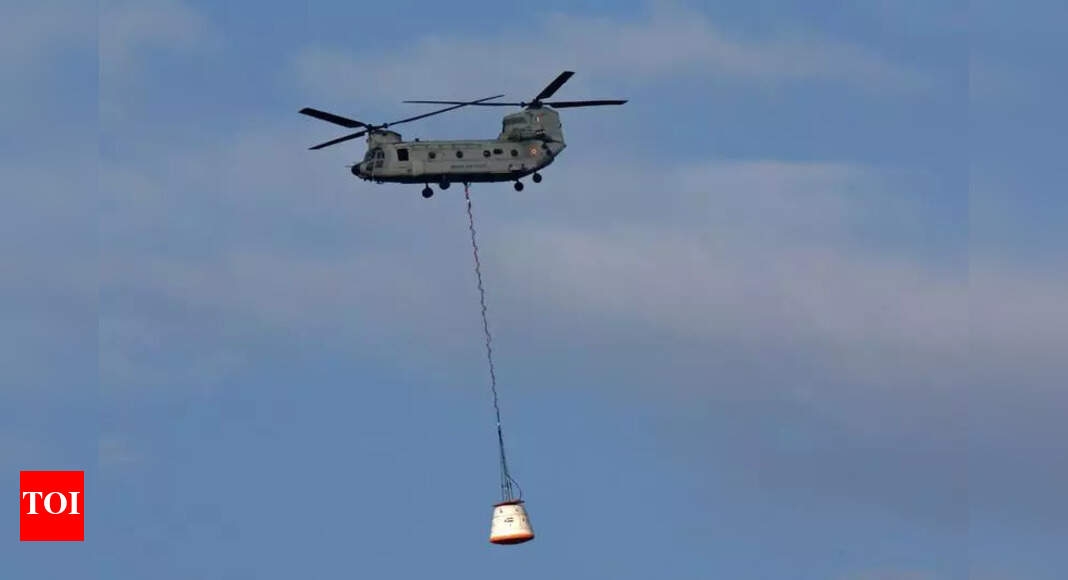Science
Agra Lab Achieves Key Milestone for India’s Gaganyaan Mission

The Aerial Delivery Research & Development Establishment (ADRDE), located in Agra, India, successfully conducted a pivotal test for the country’s Gaganyaan mission on Sunday. The Integrated Aerial Drop Test (IADT-01) took place at the Satish Dhawan Space Centre in Sriharikota, confirming the effectiveness of the parachute-based deceleration system essential for India’s first human spaceflight initiative.
During the test, a 4.8-ton dummy crew module was air-dropped from a Chinook helicopter at an altitude of 3 km, approximately 30 km offshore. All ten integrated Gaganyaan parachutes, engineered by ADRDE, deployed successfully. The test objectives included verifying apex cover separation, pyro mechanisms, onboard logic, parachute performance, and crew module dynamics. According to ADRDE, the performance of the parachutes exceeded expectations, allowing for a packed life extension from six months to over a year.
The project was spearheaded by Swadesh Kumar, who emphasized the significance of the recovery parachute system. This system is designed to decelerate the crew module safely post-reentry, ensuring a controlled descent to a safe splashdown speed after the activation of heat shields and drogue parachutes. The IADT-01 test simulated realistic conditions, allowing the module to descend following a precise parachute deployment sequence.
Significance of the Test
The success of IADT-01 represents a critical advancement in validating the crew escape mechanisms and ground recovery operations necessary for Gaganyaan. This milestone sets the stage for future trials, including the upcoming TV-D2 and G1 missions, aimed at enhancing astronaut safety throughout the ascent, descent, and splashdown phases—identified as the riskiest segments of the mission.
The chairman of the Indian Space Research Organisation (ISRO) commended the ADRDE team for their essential contributions to this achievement, acknowledging their expertise in parachute system development. The results of this test not only bolster confidence in the Gaganyaan mission but also reflect the collaborative efforts and innovations within India’s aerospace sector.
As Gaganyaan progresses, the successful deployment of the parachute system will ensure that astronauts can safely return to Earth, marking a significant step forward in India’s aspirations for human space exploration.
-

 World4 months ago
World4 months agoSBI Announces QIP Floor Price at ₹811.05 Per Share
-

 Lifestyle4 months ago
Lifestyle4 months agoCept Unveils ₹3.1 Crore Urban Mobility Plan for Sustainable Growth
-

 Science3 months ago
Science3 months agoNew Blood Group Discovered in South Indian Woman at Rotary Centre
-

 Sports3 months ago
Sports3 months agoBroad Advocates for Bowling Change Ahead of Final Test Against India
-

 World4 months ago
World4 months agoTorrential Rains Cause Flash Flooding in New York and New Jersey
-

 Top Stories4 months ago
Top Stories4 months agoKonkani Cultural Organisation to Host Pearl Jubilee in Abu Dhabi
-

 Science4 months ago
Science4 months agoNothing Headphone 1 Review: A Bold Contender in Audio Design
-

 Top Stories4 months ago
Top Stories4 months agoAir India Crash Investigation Highlights Boeing Fuel Switch Concerns
-

 Sports3 months ago
Sports3 months agoCristian Totti Retires at 19: Pressure of Fame Takes Toll
-

 Business4 months ago
Business4 months agoIndian Stock Market Rebounds: Sensex and Nifty Rise After Four-Day Decline
-

 Politics4 months ago
Politics4 months agoAbandoned Doberman Finds New Home After Journey to Prague
-

 Top Stories4 months ago
Top Stories4 months agoPatna Bank Manager Abhishek Varun Found Dead in Well









